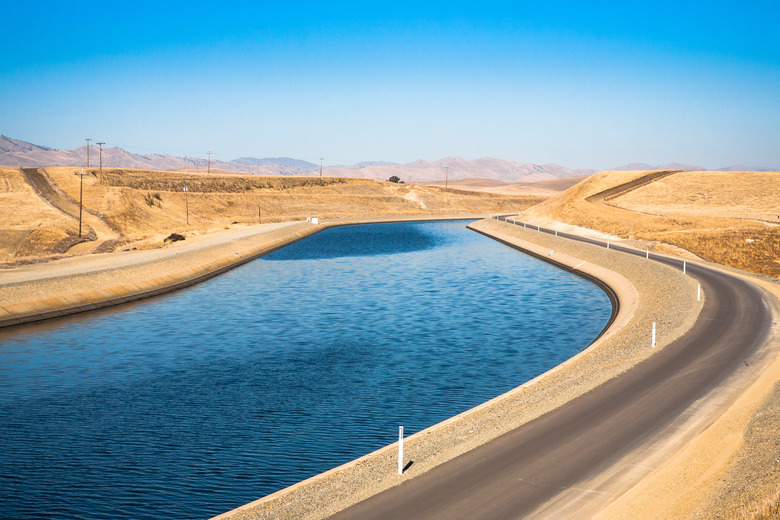How To Calculate Gravity Flow
Gravitational flow rate is calculated using Manning's Equation, which applies to the uniform flow rate in an open channel system that is not affected by pressure. A few examples of open channel systems include streams, rivers, and man-made open channels such as pipes. Flow rate is dependent on the area of the channel and velocity of the flow. If there is a change in slope or if there is a bend in the channel, the depth of water will change, which will affect the velocity of the flow.
Step 1
Write down the equation for calculating volumetric flow rate Q due to gravity: Q = AV, where A is the cross-sectional area of flow perpendicular to the flow direction and V is the cross-sectional average velocity of the flow.
Step 2
Using a calculator, determine the cross-sectional area A of the open channel system you are working with. For instance, if you are trying to find the cross-sectional area of a circular pipe, the equation would be
\(A = \frac{\pi}{4}D^2\)
where D is the inside diameter of the pipe. If the diameter of the pipe is D = .5 feet, then the cross-sectional area is:
\(A = \frac{\pi}{4}(0.5\text{ ft})^2=0.196\text{ ft}^2\)
Step 3
Write down the formula for the average velocity V of the cross-section:
\(V=\frac{k}{n}R_h^{2/3}S^{1/2}\)
where n is the Manning roughness coefficient or empirical constant, Rh is the hydraulic radius, S is the bottom slope of the channel and k is a conversion constant, which is dependent on the type of unit system you are using. If you are using U.S. customary units, k = 1.486 and for SI units 1.0. In order to solve this equation, you will need to calculate the hydraulic radius and the slope of the open channel.
Step 4
Calculate the hydraulic radius Rh of the open channel using the following formula Rh = A/P, where A is the cross-sectional area of flow and P is the wetted perimeter (the perimeter of the cross-section). For example, if your pipe has an area A of 0.196 ft² and a perimeter of P = 1.57 ft, then the hydraulic radius is equal to
\(R_h=\frac{A}{P}=\frac{1.96\text{ ft}^2}{1.57\text{ ft}}=0.125\text{ ft}\)
Step 5
Calculate the bottom slope S of the channel using S = hf/L, or by using the algebraic formula slope = rise divided by run, by picturing the pipe as being a line on an x-y grid. The rise is determined by the change in the vertical distance y and the run can be determined as the change in the horizontal distance x. For instance, you found the change in y = 6 feet and the change in x = 2 feet, so slope S is
\(S=\frac{\Delta y}{\Delta x}=\frac{6\text{ ft}}{2\text{ ft}}=3\)
Step 6
Determine the value of Manning's roughness coefficient n for the area you are working in, keeping in mind that this value is area-dependent and can vary throughout your system. The selection of the value can greatly affect the computational result, so it is often chosen from a table of set constants, but can be back-calculated from field measurements. For example, you found the Manning coefficient of a fully coated metal pipe to be 0.024 s/(m1/3) from the Hydraulic Roughness Table.
Step 7
Calculate the value of the average velocity V of the flow by plugging in the values you determined for n, S and Rh into the equation for V. For instance, if we found S = 3, Rh = .125 ft, n = 0.024 and k = 1.486, then V will equal
\(V=\frac{k}{n}R_h^{2/3}S^{1/2}=\frac{1.486}{0.24}0.125^{2/3}3^{1/2}=26.81\text{ ft/s}\)
Step 8
Calculating the volumetric flow rate Q due to gravity: Q = AV. If A = 0.196 ft² and V = 26.81 ft/s, then the gravitational flow rate Q is:
\(Q = AV=(0.196\text{ ft}^2)(26.81\text{ ft/s})=5.26\text{ ft}^3\text{/s}\)
So the volumetric water flow rate passing through the stretch of channel is 5.26 ft³/s .
References
- ODOT Hydraulics Manual: Hydraulic Roughness (Manning's n) Values of Conduits and Channels
- United States Geological Survey Water: Guide for Selecting Manning's Roughness Coefficients for Natural Channels and Flood Planes
- Water/ Waste Water Distance Learning: Manning's Equation and Manipulation of Empirical Equation
- Channel Flow Resistance: Centinnal of Manning's Equation; Ben Chie Yen; 1992
- Flow in Open Channels: K Subramany; 1997
Cite This Article
MLA
Coswell, Angel. "How To Calculate Gravity Flow" sciencing.com, https://www.sciencing.com/calculate-gravity-flow-6561698/. 2 November 2020.
APA
Coswell, Angel. (2020, November 2). How To Calculate Gravity Flow. sciencing.com. Retrieved from https://www.sciencing.com/calculate-gravity-flow-6561698/
Chicago
Coswell, Angel. How To Calculate Gravity Flow last modified March 24, 2022. https://www.sciencing.com/calculate-gravity-flow-6561698/
